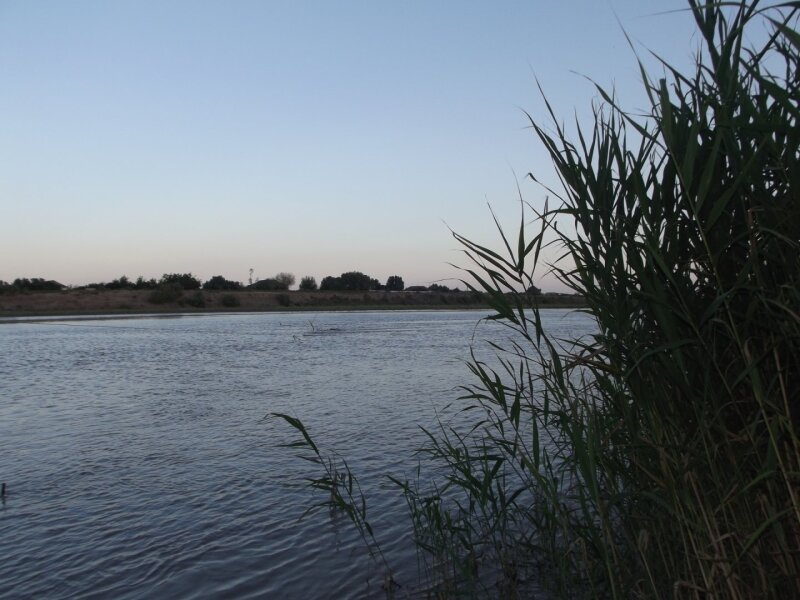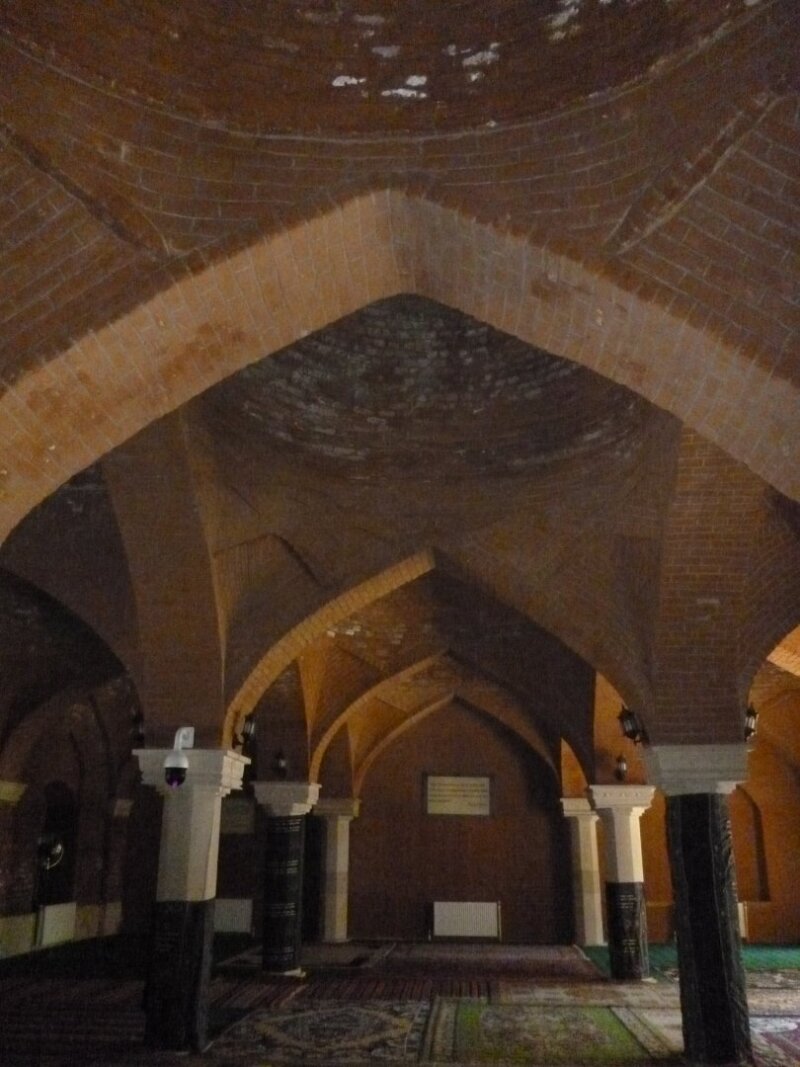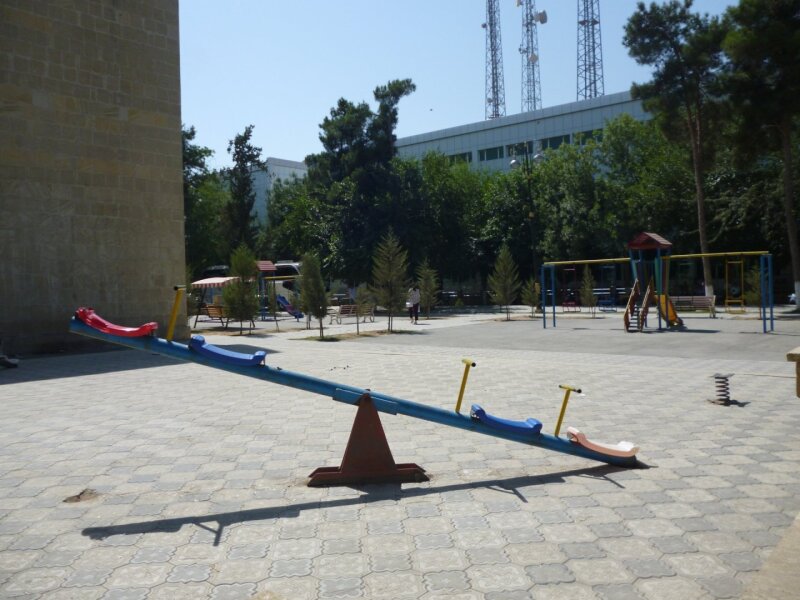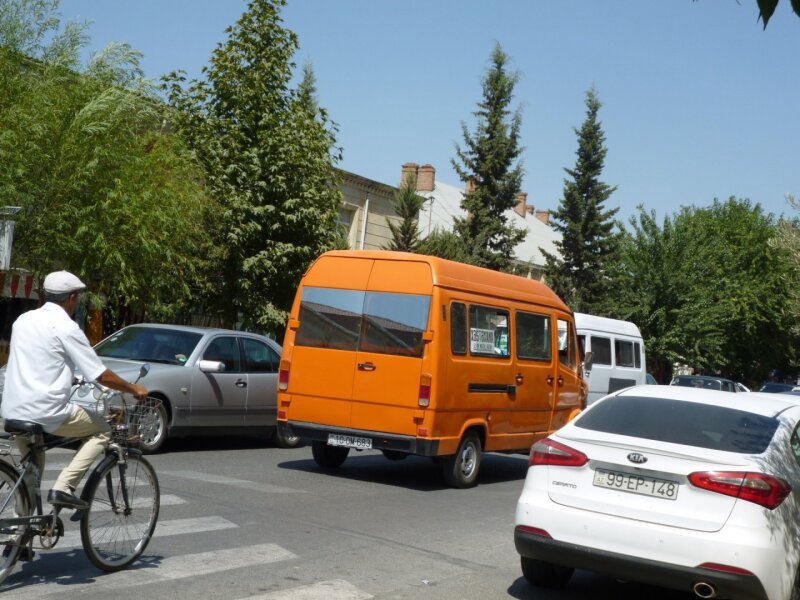2025-04-06
Salyan is a town in Azerbaijan that has a very basic infrastructure: there is very limited public transportation , no biking lanes, small uninviting public parks, and limited cultural and social amenities. The town is not highly urbanized, which can help to maintain and conserve resources, and is not overly affected by noise or air pollution. The town has a good potential for recreational services, considering its closeness to the water. In general, the town is distinguished for its semi-arid climate. The town’s major water source is the longest river of the South Caucasus, the Kura River, which circles around the town like a belt. However, in recent years the river can be on the brink of ecological disaster due to rapidly decreasing water levels and pollution.
In order to give a clear picture of Salyan town, I am presenting existing infrastructure challenges through pictures. Hopefully, the pictures will help to depict the existing situation there.
Kura river
Image: Incha AliyevaThe region of Salyan (also known as a rayonExternal link) has a total population of 139.000 as of 2020, including people living in Salyan city and its villages. However, the number of people living in Salyan city is about 44.000. According to the OECD definitionExternal link, an urban centre is a pure grid-based concept, a cluster of contiguous cells of high density with more than 50,000 inhabitants. Because Salyan falls a bit short of the city concept according to this definition, it will be referred here as a town; however, in Azerbaijan, Salyan is referred to as a city.
The town is one of the oldest areas inhabited by humans due to its proximity to freshwater sources and mild climate. Despite periodically unearthed findings as a result of archeological discoveries,External link such as the material remains of past human life and activities, the historical monuments dating back before the 20th century are still limited. This might be due to the fact that historically, Salyan was not a major economic-political center of the region, therefore not so many historical-cultural monuments were built. For instance, there is only a locally well-known mosque, Juma Mosque, in the town center that dates back to the late 19th century. In the meantime, over the last few decades, the town’s cultural and social life has lagged behind.
Inside XIX century mosque
Image: Incha AliyevaI would say in modern days the town’s only ‘melting pot’ area is the bazar square until 2-3 pm, after that, the town covers itself with dead silence. There might be a couple of spaces where socializing occurs after this peak time, such as in the teahouses, locally called “chaikhanas”. The very essential feature of these chaikhanas is that they are male dominated. It is exceptionally rare to see woman there, let alone a local woman. The existence of such spaces support pervasive male domination, ‘mansplaining,’ gap between genders, creation of gendered roles in a family and society and list can go on.
The social benefits of green urban space are indisputable. According to the Urban Green Space Interventions and Health reportExternal link, urban green space is a necessary component for delivering healthy, sustainable and livable cities. Interventions to increase or improve urban green space can deliver positive health, social and environmental outcomes for all population groups, particularly among lower socioeconomic status groups. In Salyan’s case the eco-social efficiency of the town is low, considering the infrastructure provided to the locals. This can include a lack of green recreational spaces, urban squares free of cars, social cafes promoting gender balance, creative youth spaces free of censorship, diversity, lack of biking lines and low pedestrian friendliness.
Children’s playground in city center
Image: Incha AliyevaIn order to resolve these issues along with local government’s involvement, a citizen participatory approach should be adopted – involvement of the citizens, architects, youth, designers, creative minds and so on is essential. This complex procedure will not only improve the town’s infrastructure and its livability index, but also literally will green the grey spirit of the city.
The following discussion and recommendations target how to fuel the town’s infrastructure, livability, creativity/creative outlets, social interactions and social services.
One of the essential elements in a town or city infrastructure are parks. Research showsExternal link increasing urban nature could potentially provide mental health benefits while simultaneously protecting biodiversity and ecosystem services of natural environments. In Salyan, the majority live in houses rather than apartments, which means they have backyards, but this does not mean that the town does not need big parks, biking lines, and spaces for socializing. During the COVID lockdown, the value of these backyards has been treasured, however this was not sufficient for coping with the increase in depression and anxiety levels that I observed after the pandemic lockdown. Thus, connection to nature is not only essential for well-being and biodiversity, but also for socialization. Considering this fact, the first thing to do as a city municipality is to improve a town’s parks and urban green spaces.
Large forests grow in some regions of Azerbaijan (even though someExternal link face deforestationExternal link[1]), however in Salyan this is not the case, at least in the last 50 years. The thick Tugay forests that once grew along the Kura river are now tremendously diminished. Therefore, reforestation in Salyan can be a solution that brings the particular benefits of urban forestsExternal link, like improving public health, enriching habitats, mitigating climate change, reducing urban heat, removing air pollution, and improving social and public well-being.
There are only three major ‘parks’ in the town and their services do not even come close to the Cambridge Dictionary’s definitionExternal link “a large area of land with grass and trees, usually surrounded by fences or walls, and specially arranged so that people can walk in it for pleasure or children can play in it”. The first issue with Salyan’s public parks is their limited size, considering the town population is roughly 44.000 people, the public parks of the town are considerably small. Thus, they do not serve their purpose. Other challenges with the parks are their design and infrastructure. These spaces are covered with tiles rather than trees, which does not bring that feeling of relaxation and connection with nature.
The biggest park (~4500 m2) in Salyan is named after Heydar Aliyev, the former president of Azerbaijan. During Soviet times after WWII, the park was called Qalaba, which means Victory. The city’s executive authority building and youth center, which were both erected in the 2010s, are located inside the park. The executive building takes up the limited space in the park, which makes the park more like its backyard; but still, it is a frequent visiting spot for locals. This park is also surrounded by iron fences, and a more open park design could offer more comfort and relaxation.
The parks in Salyan date back to the Soviet eraExternal link, except Municipality ParkExternal link, which was established in the early 2000s. At that time the park was not surrounded by these small shops and buildings or fenced walls, as it is now. This design blocks the town’s view, limits interaction with the surrounding area, and also it can bring a sense of exclusion. The existence of ‘chaikhana’ at the very end of the park is another challenge with the park, considering its small size (~700 m2) and domination of males among the visitors.
Municipality Park
Image: Incha AliyevaSalyan is my hometown. I visited in mid-September of 2021, and photographed these fragments. What flabbergasted me the most is how many bike riders I came across, which demonstrates the high demand for biking lines in town. The absence of biking lines not only creates safety hazards but also discourages biking. Additionally, the bike riders are usually males. Younger girls/females can be seen biking only in their neighborhood, which means that they are using bikes as a pastime, while males use them as a means of transportation. Probably, we can explain it with the mentality coming from ‘traditions’ – gender-biased norms, which at times reduce women’s and girls’ freedom of movement. Sometimes these traditions are labeled as essential values, and as a result, it puts too much burden onto women’s shoulders. All in all, the existing challenges with parks prevent them from serving local citizens properly. What is seen as a necessity is the alterations to the town’s infrastructure and services. These alterations can be realized through the initiations of government bodies and local people. The idyllic town would look like owning biking lines, pedestrian paths, botanical garden, big lush parks, car-free streets, social spaces and so on. In Salyan town’s case, these abovementioned services are not available to the public. Although I am not an urban planner, based on individual observation as someone who grew up in Salyan and visits often, I suggest that there are basic essentials that should be considered. In the preliminary stage the vital important components of urban space would be lush green parks. The another core essential service to provide for Salyan citizens would be having complete car-free urban squares with modern utilities – cafes and restaurants, play areas for kids and adults, where people can have social interactions. Urban green areasExternal link contribute to communities both physically and mentally; they are spaces where recreational needs are met, and the community identity is strengthened. As mentioned above, it is essential to ensure public participation, and to closely involve local citizens, urban planners, and artists in the process, which realize helps to generate positive economic, spatial and social outcomes.
Biking without biking lines
Image: Incha AliyevaThe pictures demonstrate the current state of the town and are shown with the aim to encourage change in the town. The perception is left to the audience, however, the main intention is to highlight the abovementioned challenges and suggestions.
Due to all the environmental challenges I have set up an environmental initiative called Beeco, portraying Azerbaijan’s and the generally existing environmental challenges worldwide; basically, I turned my passion into action. The photo credits in this piece belong to the Beeco InitiativeExternal link and please visit the Beeco Blog for more photos and information on the topicExternal link.
[1] In the last year, Beeco supported two deforestation projects in Azerbaijan: Haftoni forests and Junud-Bideyiz forests.
Acknowledgement: I would like to express my gratitude to Institute for Caucasus Studies, Tiffany G. Williams, and Tsypylma Darieva for their kind support in editing the piece and guiding me through the process.
Author Bio:
Incha Aliyeva is a specialist at Azerbaijan Tourism and Management University's International Office. She founded and leads an initiative called Beeco that aims to increase environmental awareness and literacy both locally and globally.
She earned her master’s degree in The Theory and History of Literary Criticism from Baku State University, and is currently seeking a master’s degree in Global Studies at the University of Wroclaw/University of Leipzig.
Reviewed by:
PD Dr. Tsypylma Darieva, Centre for East European and International Studies, Head of Research Cluster: Migration and Diversity



